Urbanization: Environmental Problems and Market Failures Analysis
VerifiedAdded on 2021/06/15
|8
|1559
|193
Essay
AI Summary
This essay delves into the environmental problems stemming from urbanization, framing them within the context of market failures. It begins by defining urbanization and its impact on environmental degradation, particularly highlighting the case of China. The essay explores key concepts like externalities, public goods, and intergenerational disbalance to explain how market mechanisms fail to address environmental concerns. It analyzes the increasing ecological footprint of China and presents data illustrating the environmental degradation as a percentage of the country's GNP. The essay then suggests potential solutions, including environmental taxes, trade licensing systems, and the importance of environmental education. It concludes by emphasizing the need for government intervention to implement policies that mitigate environmental damage and promote sustainable development.
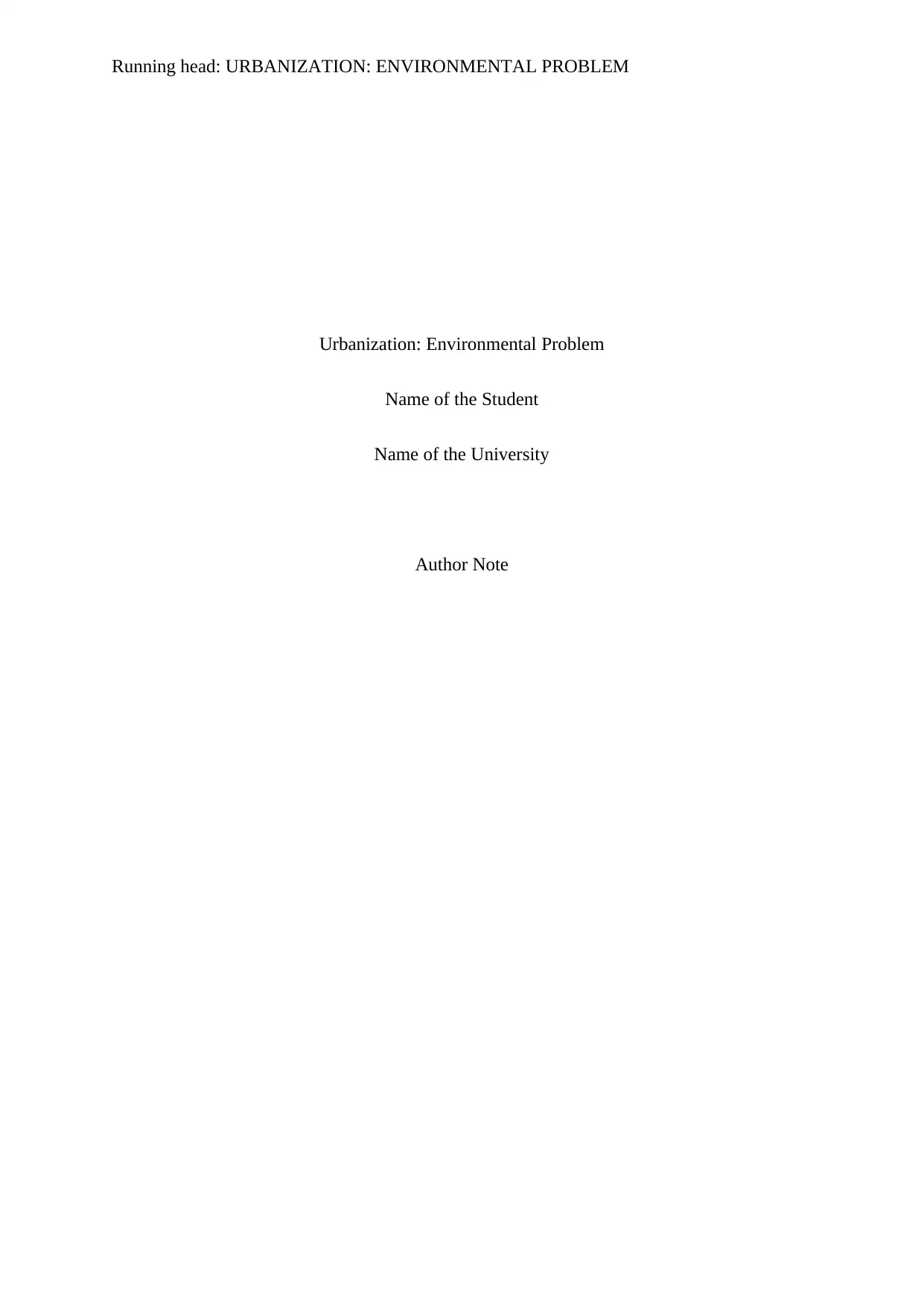
Running head: URBANIZATION: ENVIRONMENTAL PROBLEM
Urbanization: Environmental Problem
Name of the Student
Name of the University
Author Note
Urbanization: Environmental Problem
Name of the Student
Name of the University
Author Note
Paraphrase This Document
Need a fresh take? Get an instant paraphrase of this document with our AI Paraphraser
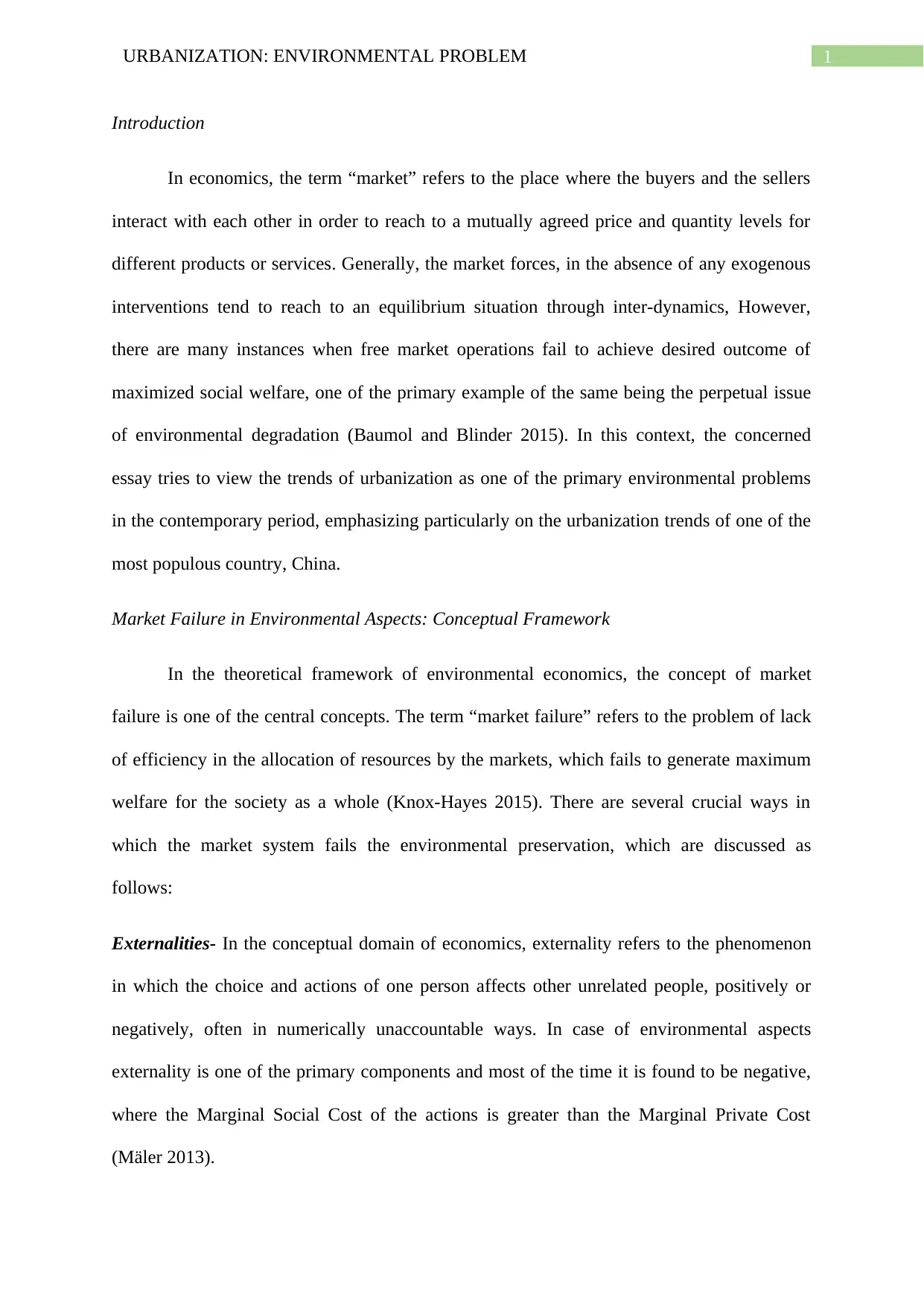
1URBANIZATION: ENVIRONMENTAL PROBLEM
Introduction
In economics, the term “market” refers to the place where the buyers and the sellers
interact with each other in order to reach to a mutually agreed price and quantity levels for
different products or services. Generally, the market forces, in the absence of any exogenous
interventions tend to reach to an equilibrium situation through inter-dynamics, However,
there are many instances when free market operations fail to achieve desired outcome of
maximized social welfare, one of the primary example of the same being the perpetual issue
of environmental degradation (Baumol and Blinder 2015). In this context, the concerned
essay tries to view the trends of urbanization as one of the primary environmental problems
in the contemporary period, emphasizing particularly on the urbanization trends of one of the
most populous country, China.
Market Failure in Environmental Aspects: Conceptual Framework
In the theoretical framework of environmental economics, the concept of market
failure is one of the central concepts. The term “market failure” refers to the problem of lack
of efficiency in the allocation of resources by the markets, which fails to generate maximum
welfare for the society as a whole (Knox-Hayes 2015). There are several crucial ways in
which the market system fails the environmental preservation, which are discussed as
follows:
Externalities- In the conceptual domain of economics, externality refers to the phenomenon
in which the choice and actions of one person affects other unrelated people, positively or
negatively, often in numerically unaccountable ways. In case of environmental aspects
externality is one of the primary components and most of the time it is found to be negative,
where the Marginal Social Cost of the actions is greater than the Marginal Private Cost
(Mäler 2013).
Introduction
In economics, the term “market” refers to the place where the buyers and the sellers
interact with each other in order to reach to a mutually agreed price and quantity levels for
different products or services. Generally, the market forces, in the absence of any exogenous
interventions tend to reach to an equilibrium situation through inter-dynamics, However,
there are many instances when free market operations fail to achieve desired outcome of
maximized social welfare, one of the primary example of the same being the perpetual issue
of environmental degradation (Baumol and Blinder 2015). In this context, the concerned
essay tries to view the trends of urbanization as one of the primary environmental problems
in the contemporary period, emphasizing particularly on the urbanization trends of one of the
most populous country, China.
Market Failure in Environmental Aspects: Conceptual Framework
In the theoretical framework of environmental economics, the concept of market
failure is one of the central concepts. The term “market failure” refers to the problem of lack
of efficiency in the allocation of resources by the markets, which fails to generate maximum
welfare for the society as a whole (Knox-Hayes 2015). There are several crucial ways in
which the market system fails the environmental preservation, which are discussed as
follows:
Externalities- In the conceptual domain of economics, externality refers to the phenomenon
in which the choice and actions of one person affects other unrelated people, positively or
negatively, often in numerically unaccountable ways. In case of environmental aspects
externality is one of the primary components and most of the time it is found to be negative,
where the Marginal Social Cost of the actions is greater than the Marginal Private Cost
(Mäler 2013).
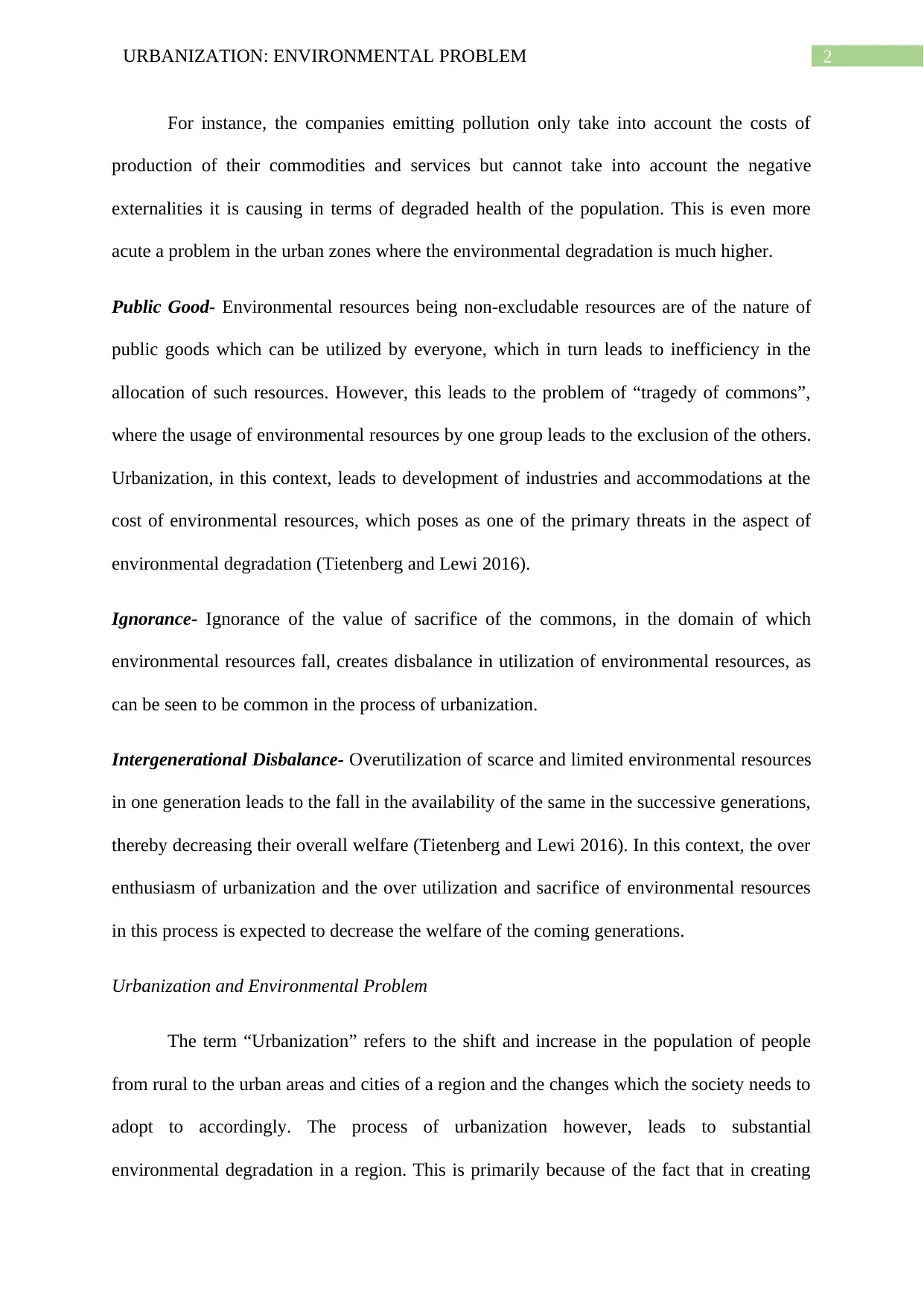
2URBANIZATION: ENVIRONMENTAL PROBLEM
For instance, the companies emitting pollution only take into account the costs of
production of their commodities and services but cannot take into account the negative
externalities it is causing in terms of degraded health of the population. This is even more
acute a problem in the urban zones where the environmental degradation is much higher.
Public Good- Environmental resources being non-excludable resources are of the nature of
public goods which can be utilized by everyone, which in turn leads to inefficiency in the
allocation of such resources. However, this leads to the problem of “tragedy of commons”,
where the usage of environmental resources by one group leads to the exclusion of the others.
Urbanization, in this context, leads to development of industries and accommodations at the
cost of environmental resources, which poses as one of the primary threats in the aspect of
environmental degradation (Tietenberg and Lewi 2016).
Ignorance- Ignorance of the value of sacrifice of the commons, in the domain of which
environmental resources fall, creates disbalance in utilization of environmental resources, as
can be seen to be common in the process of urbanization.
Intergenerational Disbalance- Overutilization of scarce and limited environmental resources
in one generation leads to the fall in the availability of the same in the successive generations,
thereby decreasing their overall welfare (Tietenberg and Lewi 2016). In this context, the over
enthusiasm of urbanization and the over utilization and sacrifice of environmental resources
in this process is expected to decrease the welfare of the coming generations.
Urbanization and Environmental Problem
The term “Urbanization” refers to the shift and increase in the population of people
from rural to the urban areas and cities of a region and the changes which the society needs to
adopt to accordingly. The process of urbanization however, leads to substantial
environmental degradation in a region. This is primarily because of the fact that in creating
For instance, the companies emitting pollution only take into account the costs of
production of their commodities and services but cannot take into account the negative
externalities it is causing in terms of degraded health of the population. This is even more
acute a problem in the urban zones where the environmental degradation is much higher.
Public Good- Environmental resources being non-excludable resources are of the nature of
public goods which can be utilized by everyone, which in turn leads to inefficiency in the
allocation of such resources. However, this leads to the problem of “tragedy of commons”,
where the usage of environmental resources by one group leads to the exclusion of the others.
Urbanization, in this context, leads to development of industries and accommodations at the
cost of environmental resources, which poses as one of the primary threats in the aspect of
environmental degradation (Tietenberg and Lewi 2016).
Ignorance- Ignorance of the value of sacrifice of the commons, in the domain of which
environmental resources fall, creates disbalance in utilization of environmental resources, as
can be seen to be common in the process of urbanization.
Intergenerational Disbalance- Overutilization of scarce and limited environmental resources
in one generation leads to the fall in the availability of the same in the successive generations,
thereby decreasing their overall welfare (Tietenberg and Lewi 2016). In this context, the over
enthusiasm of urbanization and the over utilization and sacrifice of environmental resources
in this process is expected to decrease the welfare of the coming generations.
Urbanization and Environmental Problem
The term “Urbanization” refers to the shift and increase in the population of people
from rural to the urban areas and cities of a region and the changes which the society needs to
adopt to accordingly. The process of urbanization however, leads to substantial
environmental degradation in a region. This is primarily because of the fact that in creating
⊘ This is a preview!⊘
Do you want full access?
Subscribe today to unlock all pages.

Trusted by 1+ million students worldwide
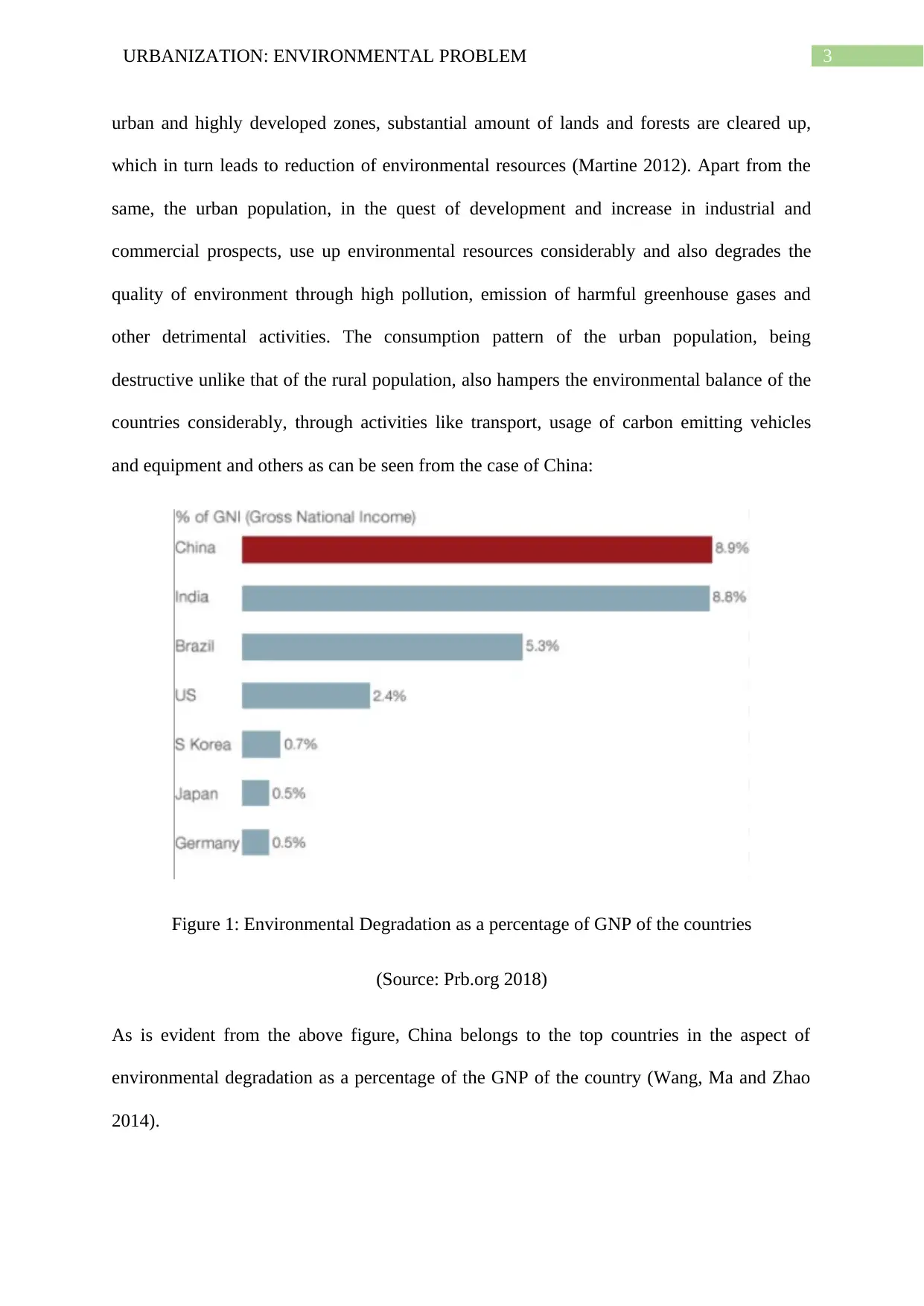
3URBANIZATION: ENVIRONMENTAL PROBLEM
urban and highly developed zones, substantial amount of lands and forests are cleared up,
which in turn leads to reduction of environmental resources (Martine 2012). Apart from the
same, the urban population, in the quest of development and increase in industrial and
commercial prospects, use up environmental resources considerably and also degrades the
quality of environment through high pollution, emission of harmful greenhouse gases and
other detrimental activities. The consumption pattern of the urban population, being
destructive unlike that of the rural population, also hampers the environmental balance of the
countries considerably, through activities like transport, usage of carbon emitting vehicles
and equipment and others as can be seen from the case of China:
Figure 1: Environmental Degradation as a percentage of GNP of the countries
(Source: Prb.org 2018)
As is evident from the above figure, China belongs to the top countries in the aspect of
environmental degradation as a percentage of the GNP of the country (Wang, Ma and Zhao
2014).
urban and highly developed zones, substantial amount of lands and forests are cleared up,
which in turn leads to reduction of environmental resources (Martine 2012). Apart from the
same, the urban population, in the quest of development and increase in industrial and
commercial prospects, use up environmental resources considerably and also degrades the
quality of environment through high pollution, emission of harmful greenhouse gases and
other detrimental activities. The consumption pattern of the urban population, being
destructive unlike that of the rural population, also hampers the environmental balance of the
countries considerably, through activities like transport, usage of carbon emitting vehicles
and equipment and others as can be seen from the case of China:
Figure 1: Environmental Degradation as a percentage of GNP of the countries
(Source: Prb.org 2018)
As is evident from the above figure, China belongs to the top countries in the aspect of
environmental degradation as a percentage of the GNP of the country (Wang, Ma and Zhao
2014).
Paraphrase This Document
Need a fresh take? Get an instant paraphrase of this document with our AI Paraphraser
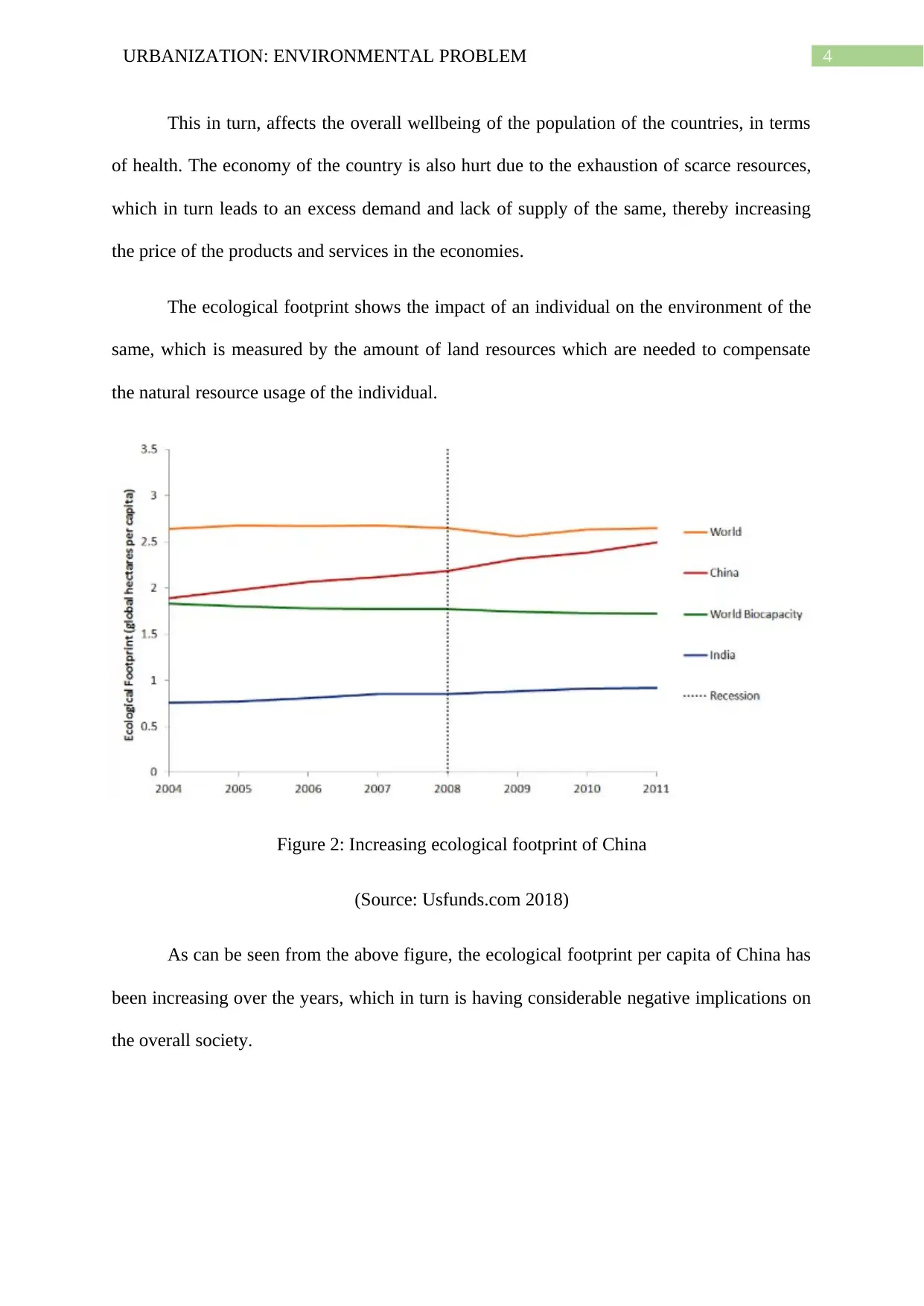
4URBANIZATION: ENVIRONMENTAL PROBLEM
This in turn, affects the overall wellbeing of the population of the countries, in terms
of health. The economy of the country is also hurt due to the exhaustion of scarce resources,
which in turn leads to an excess demand and lack of supply of the same, thereby increasing
the price of the products and services in the economies.
The ecological footprint shows the impact of an individual on the environment of the
same, which is measured by the amount of land resources which are needed to compensate
the natural resource usage of the individual.
Figure 2: Increasing ecological footprint of China
(Source: Usfunds.com 2018)
As can be seen from the above figure, the ecological footprint per capita of China has
been increasing over the years, which in turn is having considerable negative implications on
the overall society.
This in turn, affects the overall wellbeing of the population of the countries, in terms
of health. The economy of the country is also hurt due to the exhaustion of scarce resources,
which in turn leads to an excess demand and lack of supply of the same, thereby increasing
the price of the products and services in the economies.
The ecological footprint shows the impact of an individual on the environment of the
same, which is measured by the amount of land resources which are needed to compensate
the natural resource usage of the individual.
Figure 2: Increasing ecological footprint of China
(Source: Usfunds.com 2018)
As can be seen from the above figure, the ecological footprint per capita of China has
been increasing over the years, which in turn is having considerable negative implications on
the overall society.
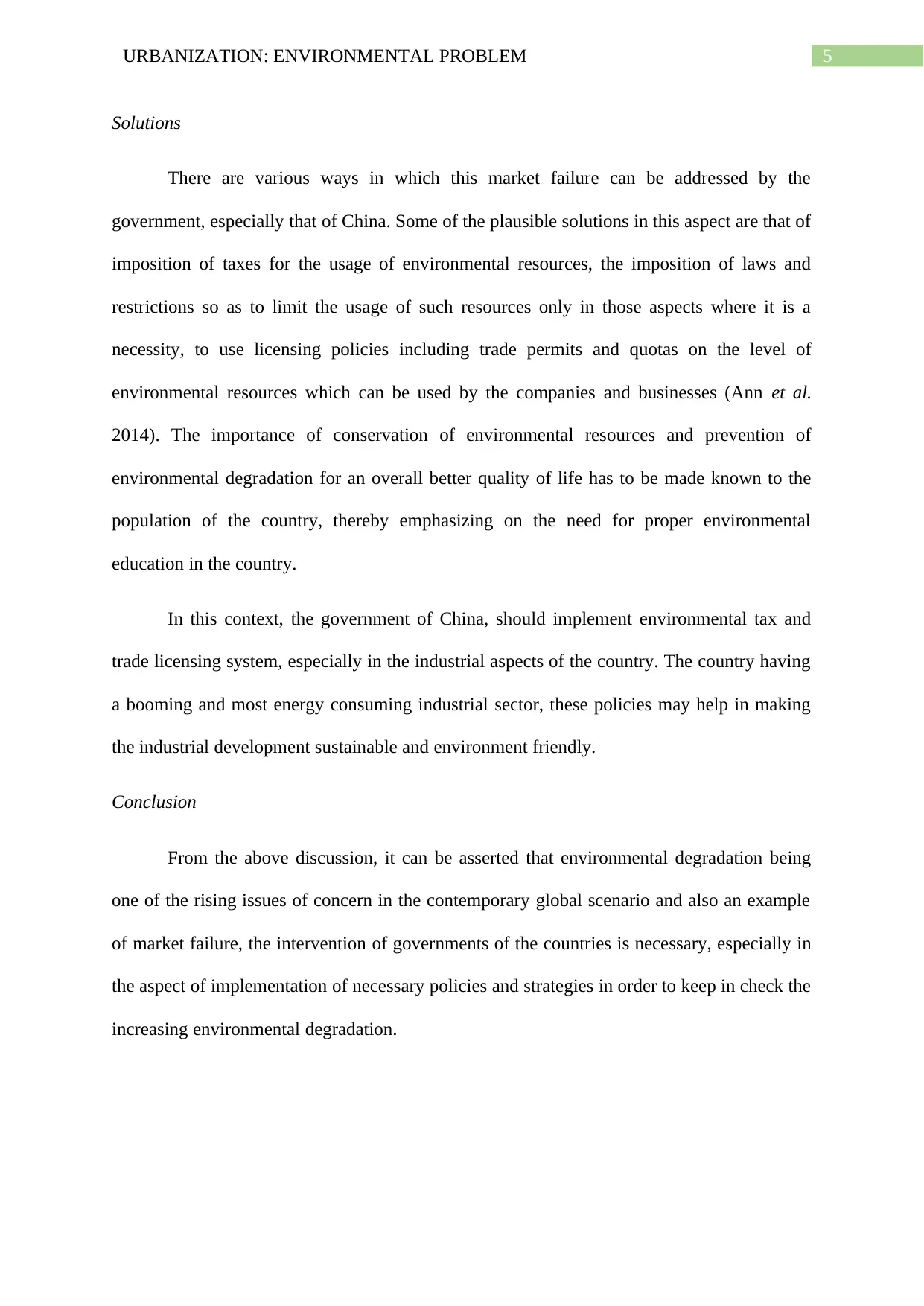
5URBANIZATION: ENVIRONMENTAL PROBLEM
Solutions
There are various ways in which this market failure can be addressed by the
government, especially that of China. Some of the plausible solutions in this aspect are that of
imposition of taxes for the usage of environmental resources, the imposition of laws and
restrictions so as to limit the usage of such resources only in those aspects where it is a
necessity, to use licensing policies including trade permits and quotas on the level of
environmental resources which can be used by the companies and businesses (Ann et al.
2014). The importance of conservation of environmental resources and prevention of
environmental degradation for an overall better quality of life has to be made known to the
population of the country, thereby emphasizing on the need for proper environmental
education in the country.
In this context, the government of China, should implement environmental tax and
trade licensing system, especially in the industrial aspects of the country. The country having
a booming and most energy consuming industrial sector, these policies may help in making
the industrial development sustainable and environment friendly.
Conclusion
From the above discussion, it can be asserted that environmental degradation being
one of the rising issues of concern in the contemporary global scenario and also an example
of market failure, the intervention of governments of the countries is necessary, especially in
the aspect of implementation of necessary policies and strategies in order to keep in check the
increasing environmental degradation.
Solutions
There are various ways in which this market failure can be addressed by the
government, especially that of China. Some of the plausible solutions in this aspect are that of
imposition of taxes for the usage of environmental resources, the imposition of laws and
restrictions so as to limit the usage of such resources only in those aspects where it is a
necessity, to use licensing policies including trade permits and quotas on the level of
environmental resources which can be used by the companies and businesses (Ann et al.
2014). The importance of conservation of environmental resources and prevention of
environmental degradation for an overall better quality of life has to be made known to the
population of the country, thereby emphasizing on the need for proper environmental
education in the country.
In this context, the government of China, should implement environmental tax and
trade licensing system, especially in the industrial aspects of the country. The country having
a booming and most energy consuming industrial sector, these policies may help in making
the industrial development sustainable and environment friendly.
Conclusion
From the above discussion, it can be asserted that environmental degradation being
one of the rising issues of concern in the contemporary global scenario and also an example
of market failure, the intervention of governments of the countries is necessary, especially in
the aspect of implementation of necessary policies and strategies in order to keep in check the
increasing environmental degradation.
⊘ This is a preview!⊘
Do you want full access?
Subscribe today to unlock all pages.

Trusted by 1+ million students worldwide
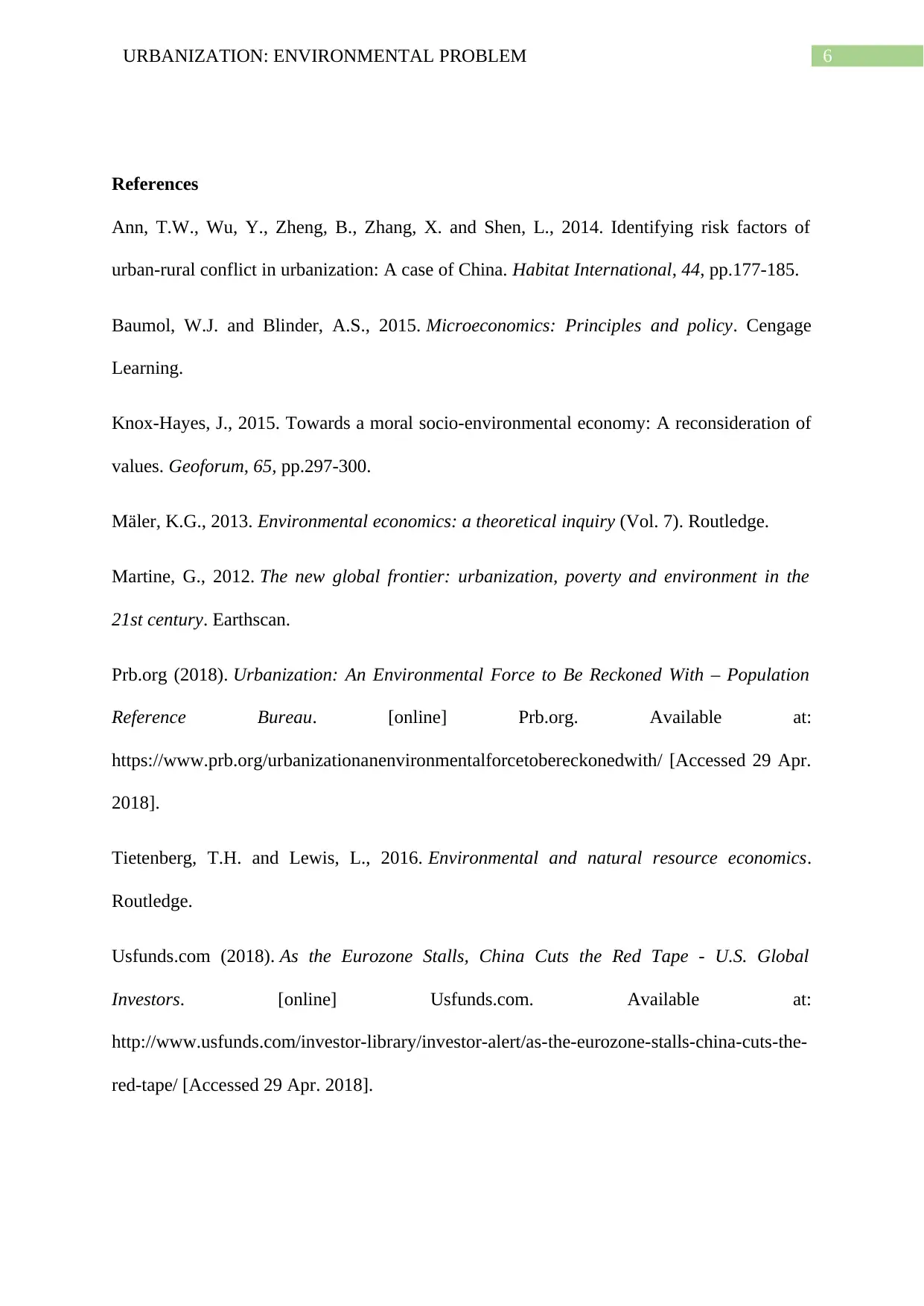
6URBANIZATION: ENVIRONMENTAL PROBLEM
References
Ann, T.W., Wu, Y., Zheng, B., Zhang, X. and Shen, L., 2014. Identifying risk factors of
urban-rural conflict in urbanization: A case of China. Habitat International, 44, pp.177-185.
Baumol, W.J. and Blinder, A.S., 2015. Microeconomics: Principles and policy. Cengage
Learning.
Knox-Hayes, J., 2015. Towards a moral socio-environmental economy: A reconsideration of
values. Geoforum, 65, pp.297-300.
Mäler, K.G., 2013. Environmental economics: a theoretical inquiry (Vol. 7). Routledge.
Martine, G., 2012. The new global frontier: urbanization, poverty and environment in the
21st century. Earthscan.
Prb.org (2018). Urbanization: An Environmental Force to Be Reckoned With – Population
Reference Bureau. [online] Prb.org. Available at:
https://www.prb.org/urbanizationanenvironmentalforcetobereckonedwith/ [Accessed 29 Apr.
2018].
Tietenberg, T.H. and Lewis, L., 2016. Environmental and natural resource economics.
Routledge.
Usfunds.com (2018). As the Eurozone Stalls, China Cuts the Red Tape - U.S. Global
Investors. [online] Usfunds.com. Available at:
http://www.usfunds.com/investor-library/investor-alert/as-the-eurozone-stalls-china-cuts-the-
red-tape/ [Accessed 29 Apr. 2018].
References
Ann, T.W., Wu, Y., Zheng, B., Zhang, X. and Shen, L., 2014. Identifying risk factors of
urban-rural conflict in urbanization: A case of China. Habitat International, 44, pp.177-185.
Baumol, W.J. and Blinder, A.S., 2015. Microeconomics: Principles and policy. Cengage
Learning.
Knox-Hayes, J., 2015. Towards a moral socio-environmental economy: A reconsideration of
values. Geoforum, 65, pp.297-300.
Mäler, K.G., 2013. Environmental economics: a theoretical inquiry (Vol. 7). Routledge.
Martine, G., 2012. The new global frontier: urbanization, poverty and environment in the
21st century. Earthscan.
Prb.org (2018). Urbanization: An Environmental Force to Be Reckoned With – Population
Reference Bureau. [online] Prb.org. Available at:
https://www.prb.org/urbanizationanenvironmentalforcetobereckonedwith/ [Accessed 29 Apr.
2018].
Tietenberg, T.H. and Lewis, L., 2016. Environmental and natural resource economics.
Routledge.
Usfunds.com (2018). As the Eurozone Stalls, China Cuts the Red Tape - U.S. Global
Investors. [online] Usfunds.com. Available at:
http://www.usfunds.com/investor-library/investor-alert/as-the-eurozone-stalls-china-cuts-the-
red-tape/ [Accessed 29 Apr. 2018].
Paraphrase This Document
Need a fresh take? Get an instant paraphrase of this document with our AI Paraphraser
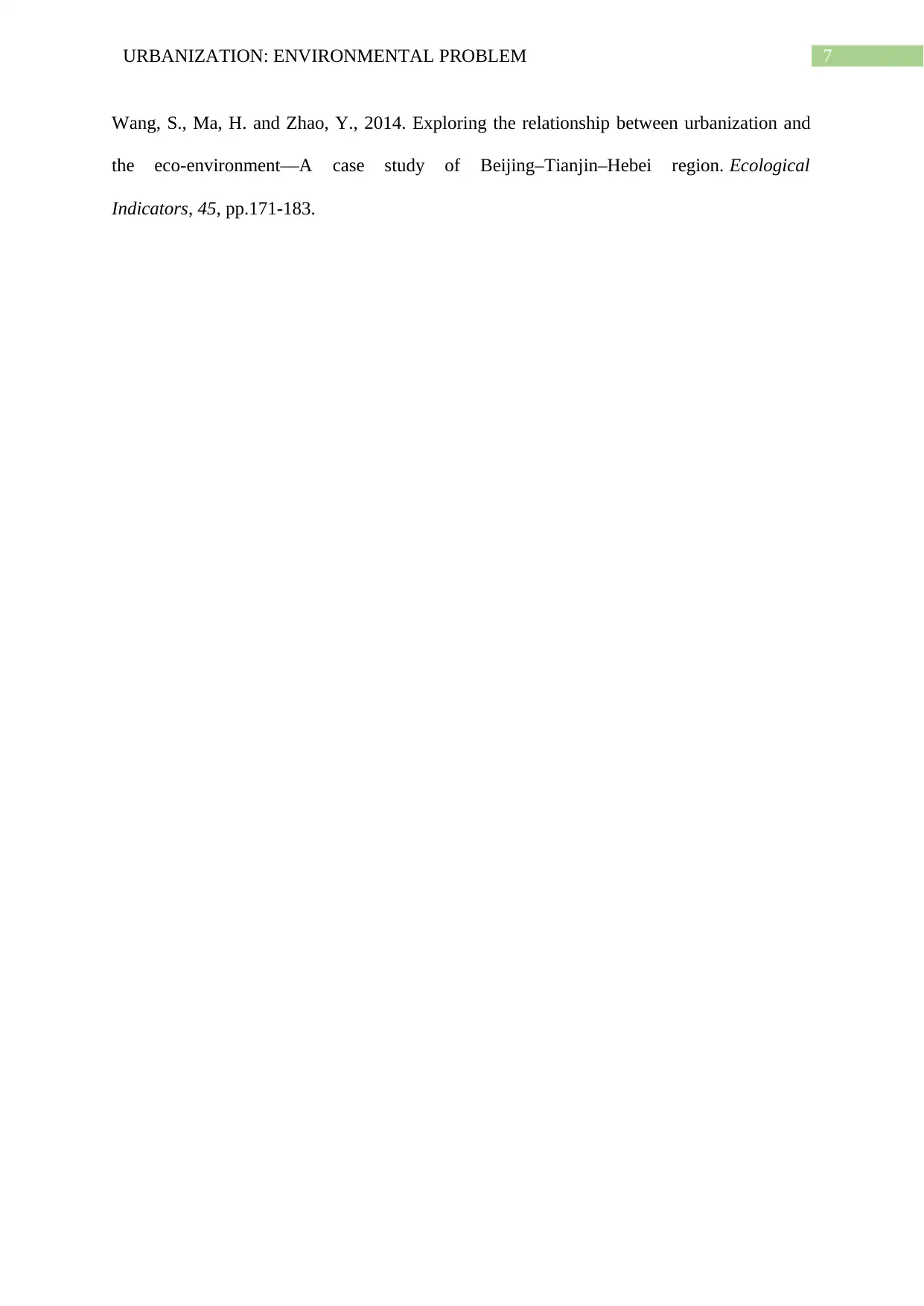
7URBANIZATION: ENVIRONMENTAL PROBLEM
Wang, S., Ma, H. and Zhao, Y., 2014. Exploring the relationship between urbanization and
the eco-environment—A case study of Beijing–Tianjin–Hebei region. Ecological
Indicators, 45, pp.171-183.
Wang, S., Ma, H. and Zhao, Y., 2014. Exploring the relationship between urbanization and
the eco-environment—A case study of Beijing–Tianjin–Hebei region. Ecological
Indicators, 45, pp.171-183.
1 out of 8
Related Documents
Your All-in-One AI-Powered Toolkit for Academic Success.
+13062052269
info@desklib.com
Available 24*7 on WhatsApp / Email
![[object Object]](/_next/static/media/star-bottom.7253800d.svg)
Unlock your academic potential
Copyright © 2020–2025 A2Z Services. All Rights Reserved. Developed and managed by ZUCOL.
![[Year] ABC Company: Market Failure and Environment in Economic Context](/_next/image/?url=https%3A%2F%2Fdesklib.com%2Fmedia%2Fimages%2F658e5453c376427285461096c079d2b6.jpg&w=256&q=75)




